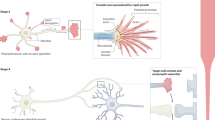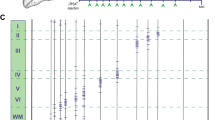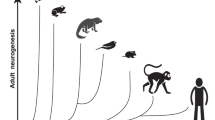Transient cells of the developing mammalian telencephalon are peptide-immunoreactive neurons (original) (raw)
- Letter
- Published: 18 February 1987
Nature volume 325, pages 617–620 (1987)Cite this article
- 201 Accesses
- 309 Citations
- 3 Altmetric
- Metrics details
Abstract
In the development of the mammalian telencephalon, the genesis of neurons destined for the various layers of the cerebral cortex is preceded by the generation of a population of cells that comes to reside in the subplate and marginal zones1 (see ref. 2 for nomenclature). In the cat, these cells are present in large numbers during development, when their location is correlated with the arrival and accumulation of ingrowing axonal systems3–6 and with synapses7–12. However, as the brain matures, the cells disappear and the white matter and layer 1 of the adult emerge1,13,14. Their disappearance occurs in concert with the invasion of the cortical plate by the axonal systems and with the elimination of the synapses from the subplate1,4,7,9,12. Here we report that the subplate cells have properties typical of mature neurons. They have the ultra-structural appearance of neurons and receive synaptic contacts. They also have long projections and are immunoreactive for MAP2 (microtubule associated protein 2). Further, subpopulations are immunoreactive for one of several neuropeptides. These observations suggest that during the fetal and early postnatal development of the mammalian telencephalon the subplate cells function as neurons in synaptic circuitry that disappears by adulthood.
This is a preview of subscription content, access via your institution
Access options
Subscribe to this journal
Receive 51 print issues and online access
$199.00 per year
only $3.90 per issue
Buy this article
- Purchase on SpringerLink
- Instant access to full article PDF
Prices may be subject to local taxes which are calculated during checkout
Additional access options:
Similar content being viewed by others


Development of prefrontal cortex
Article Open access 13 October 2021

References
- Luskin, M. B. & Shatz, C. J. J. Neurosci 5, 1062–1075 (1985).
Article CAS Google Scholar - Sidman, R. L. & Rakic, P. Brain Res. 62, 1–35 (1973).
Article CAS Google Scholar - Luskin, M. B. & Shatz, C. J. Soc. Neurosci. Abs. 10, 1079 (1984).
Google Scholar - Shatz, C. J. & Luskin, M. B. J. Neurosci 6, 3655–3668 (1986).
Article CAS Google Scholar - Rakic, P. Phil. Trans. R. Soc. B278, 245–260 (1977).
Article ADS Google Scholar - Lund, R. D. & Mustari, M. J. J. comp. Neurol. 173, 289–306 (1977).
Article CAS Google Scholar - Molliver, M. E., Kostovic, I. & Van Der Loos, H. Brain Res. 50, 403–407 (1973).
Article CAS Google Scholar - Kostovic, I. & Molliver, M. E. Anat. Rec. 178, 395 (1974).
Google Scholar - Cragg, B. G. J. comp. Neurol. 160, 147–166 (1975).
Article CAS Google Scholar - Blue, M. E. & Parnavelas, J. G. J. Neurocytol. 12, 599–616 (1983).
Article CAS Google Scholar - Blue, M. E. & Parnavelas, J. G. J. Neurocytol. 12, 697–712 (1983).
Article CAS Google Scholar - Chun, J. J. M. & Shatz, C. J. Soc. Neurosci. Abstr. 9, 692 (1983).
Google Scholar - Kostovic, I. & Rakic, P. J. Neurocytol. 9, 219–242 (1980).
Article CAS Google Scholar - Parnavelas, J. G. & Edmunds, S. M. J. Neurocytol. 12, 863–871 (1983).
Article CAS Google Scholar - Luskin, M. B. & Shatz, C. J. J. comp. Neurol. 242, 611–631 (1985).
Article CAS Google Scholar - De Camilli, P., Miller, P. E., Navone, F., Theurkauf, W. E. & Vallee, R. B. Neuroscience 11, 819–846 (1984).
Article Google Scholar - Bernhardt, R., Huber, G. & Matus, A. J. Neurosci. 5, 977–991 (1985).
Article CAS Google Scholar - Laemle, L. K., Feldman, S. C. & Lichtenstein, E. Brain Res. 251, 365–370 (1982).
Article CAS Google Scholar - Somogyi, P. et al. J. Neurosci. 4, 2590–2603 (1984).
Article CAS Google Scholar - Hendry, S. H. C., Jones, E. G. & Emson, P. C. J. Neurosci. 4, 2497–2517 (1984).
Article CAS Google Scholar - Hendry, S. H. C. et al. Proc. natn. Acad. Sci. U.S.A. 81, 6526–6530 (1984).
Article ADS CAS Google Scholar - Chan-Palay, V., Allen, Y. S., Lang, W., Haesler, U. & Polak, J. M. J. comp. Neurol. 238, 382–389 (1985).
Article CAS Google Scholar - Hickey, T. L., Whikehart, D. R., Jackson, C. A., Hitchcock, P. F. & Peduzzi J. D. J. Neurosci Methods 8, 139–147 (1983).
Article CAS Google Scholar - Raedler, E. & Raedler, A. Anat. Embryol. 154, 267–284 (1978).
Article CAS Google Scholar - Caviness, V. S. Jr Devl Brain Res. 4, 293–302 (1982).
Article Google Scholar - Ramon Y Cajal, S. Histologie du System Nerveux de l'Homme et des Vertebres Vol. 2 (Maloine, Paris, 1911).
Google Scholar - Bradford, R., Parnavelas, J. G. & Lieberman, A. R. J. comp. Neurol. 176, 121–132 (1977).
Article CAS Google Scholar - Marin-Padilla, M. Z. Anat. EntwGesch. 134, 125–142 (1971).
Article Google Scholar - Marin-Padilla, M. Z. Anat. EntwGesch. 136, 125–142 (1972).
Article CAS Google Scholar - Crandal, J. E., Jacobson, M. & Kosik, K. S. Devl Brain Res. 28, 127–133 (1986).
Article Google Scholar - Kostovic, I. & Fucic, A. Soc. Neurosci. Abstr. 11, 352 (1985).
Google Scholar - Wise, S. P. & Jones, E. G. J. comp. Neurol. 178, 187–208 (1978).
Article CAS Google Scholar - Innocenti, G. M. Science 212, 824–827 (1981).
Article ADS CAS Google Scholar - McLean, I. W. & Nakane, P. K. J. Histochem. Cytochem. 22, 1077–1083 (1974).
Article CAS Google Scholar - Adams, J. C. J. Histochem. Cytochem. 29, 775 (1981).
Article CAS Google Scholar
Author information
Authors and Affiliations
- Department of Neurobiology, Stanford University School of Medicine, Stanford, California, 94305, USA
J. J. M. Chun, M. J. Nakamura & C. J. Shatz
Authors
- J. J. M. Chun
- M. J. Nakamura
- C. J. Shatz
Rights and permissions
About this article
Cite this article
Chun, J., Nakamura , M. & Shatz, C. Transient cells of the developing mammalian telencephalon are peptide-immunoreactive neurons.Nature 325, 617–620 (1987). https://doi.org/10.1038/325617a0
- Received: 24 July 1986
- Accepted: 01 December 1986
- Issue Date: 18 February 1987
- DOI: https://doi.org/10.1038/325617a0